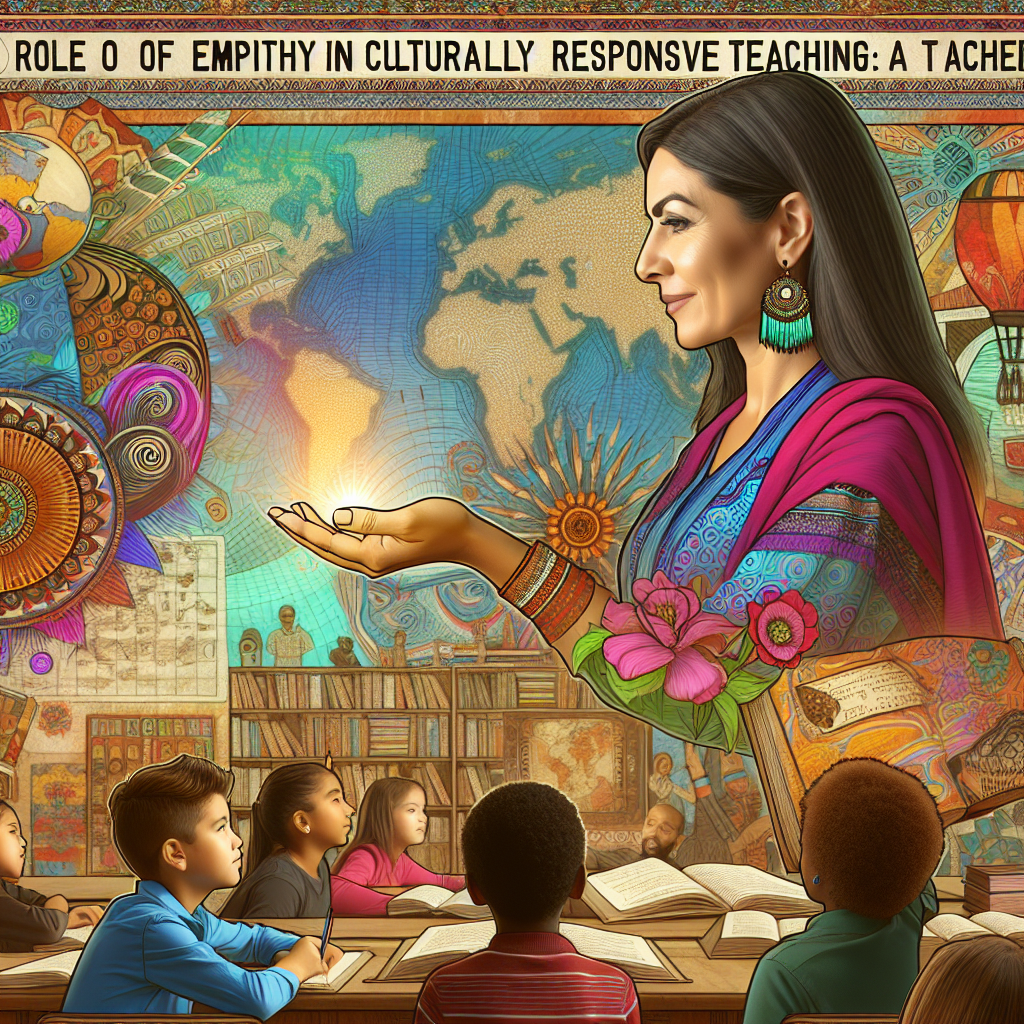
Introduction
Imagine a classroom where every student feels understood, valued, and empowered. A space where differences are celebrated rather than merely tolerated. This is the vision of culturally responsive teaching (CRT), which recognizes the diverse backgrounds, experiences, and needs of all learners. At the heart of CRT lies a powerful catalyst: empathy. In this guide, we will explore the role of empathy in culturally responsive teaching, unraveling its profound significance for educators.
By actively engaging in empathetic practices, teachers can create inclusive environments that enhance learning outcomes, boost student engagement, and foster a sense of belonging. Join us on this journey as we delve into the key elements of empathy in CRT, armed with case studies, practical strategies, and actionable insights.
Understanding the Intersection of Empathy and Culturally Responsive Teaching
What is Culturally Responsive Teaching?
Culturally responsive teaching is an educational framework that recognizes and values the diverse cultural backgrounds of students. It aims to make learning relevant to students’ experiences, facilitating deeper understanding and engagement. CRT emphasizes adapting teaching methods, materials, and assessments to reflect students’ cultural realities.
The Role of Empathy in Culturally Responsive Teaching
Empathy is more than just a feel-good concept; it is the ability to understand and share the feelings of another. In the context of culturally responsive teaching, empathy enables educators to connect with their students on a human level, acknowledging their unique circumstances and perspectives.
By practicing empathy, teachers can:
- Build Trust: Empathy fosters a safe space where students feel heard and valued.
- Promote Engagement: Understanding students’ backgrounds enhances engagement and participation.
- Facilitate Learning: Students learn better when they feel emotionally supported.
Why Empathy Matters in Education
Empathy is particularly crucial in diverse classrooms, where students come from various backgrounds and experiences. Research shows that empathetic teachers have a positive impact on student outcomes, including academic performance, social skills, and emotional well-being. Emotional connections between teachers and students lead to enhanced trust, motivation, and learning satisfaction.
Strategies for Fostering Empathy in Culturally Responsive Teaching
1. If You Want to Go Far, Go Together: Collaborative Learning
Engaging students in collaborative learning experiences can cultivate empathy among peers. When students work together on group projects, they gain insights into each other’s lives, needs, and perspectives.
Case Study: The Power of Group Projects
In a middle school in California, a teacher implemented a project where students from differing backgrounds researched each other’s cultures and presented findings to the class. This initiative not only fostered empathetic relationships but also ignited a newfound respect for cultural diversity among students.
Key Takeaway: Collaborative learning empowers students to empathize by promoting dialogue and shared experiences.
2. Listen Actively: The Art of Communication
Listening is a fundamental aspect of empathy. Practicing active listening allows educators to truly understand their students’ thoughts and feelings. Techniques such as paraphrasing and asking open-ended questions can enhance communication.
Table: Strategies for Active Listening
| Strategy | Description |
|---|---|
| Paraphrasing | Restating what the student said for clarity. |
| Open-Ended Questions | Encouraging deeper conversation with expansive questions. |
| Reflective Responses | Sharing how the student’s feelings resonate with you. |
3. Create a Safe Emotional Environment
A positive classroom climate is essential for empathy to thrive. Establishing rules and norms that prioritize safe emotional expression creates an atmosphere where students feel comfortable sharing their thoughts and feelings.
Case Study: Safe Spaces Initiative
A high school in New York introduced a “Safe Spaces” initiative, where students could share their experiences without fear of judgment. This initiative led to increased empathy among students and improved relationships with teachers.
Key Takeaway: Safe emotional environments are critical in nurturing empathetic relationships.
4. Adapt Curriculum to Reflect Diversity
Incorporating diverse perspectives and materials into the curriculum is essential for creating relevance and fostering empathy. When students see their cultures and experiences reflected in their education, they are more likely to feel valued and understood.
Case Study: Curriculum Diversification
A district in Florida revamped its literature curriculum to include authors from diverse backgrounds. This approach sparked rich discussions about culture, identity, and empathy among students, leading to more engaged learners.
Key Takeaway: A curriculum that reflects diversity fosters pride and empathy among students.
5. Use Storytelling as a Teaching Tool
Storytelling is a powerful mechanism for building empathy. Sharing stories, whether through literature or personal experiences, allows students to step into someone else’s shoes and understand differing perspectives.
Table: Benefits of Storytelling in Education
| Benefit | Description |
|---|---|
| Enhances Emotional Connection | Engaging narratives create bonds among students. |
| Encourages Critical Thinking | Analyzing different perspectives fosters deeper understanding. |
| Facilitates Discussion | Encourages meaningful conversations about experiences. |
Implementing Empathetic Practices in the Classroom
Strategies for Daily Practice
Implementing empathy into daily practices involves consistent effort and mindfulness. Here are some actionable strategies teachers can adopt:
- Morning Check-Ins: Start each day by checking in with students individually or as a class to gauge their emotional states.
- Mindfulness Activities: Incorporate mindfulness exercises that encourage students to reflect on their feelings and build emotional awareness.
- Reflective Journals: Encourage students to keep journals where they express their thoughts and feelings, promoting self-awareness and empathy.
Professional Development & Self-Reflection
Educators must engage in continuous professional development to enhance their empathetic skills. Reflecting on personal biases and areas for growth is essential for fostering a more inclusive classroom environment.
Case Study: Professional Development Workshops
A district in Texas implemented workshops focused on empathy training for teachers, leading to improved classroom dynamics and increased connection between students and teachers.
Key Takeaway: Ongoing professional development enriches teachers’ capacity for empathy.
Challenges to Empathy in Culturally Responsive Teaching
Recognizing Barriers
Despite its importance, barriers to empathy can arise in educational settings. These may include:
- Implicit Bias: Unconscious attitudes toward certain groups can hinder empathetic interactions.
- Cultural Misunderstandings: Lack of knowledge about different cultures can lead to misinterpretations and strained relationships.
Strategies to Overcome Barriers
- Increase Cultural Awareness: Engage in training and professional development that focuses on cultural competence.
- Foster Open Dialogue: Encourage conversations about differences and similarities to enhance mutual understanding.
Conclusion
The transformative role of empathy in culturally responsive teaching cannot be overstated. By understanding and embracing empathy, educators can create inclusive and equitable learning environments where every student feels represented and supported. As we move forward, let us remember that empathy is not merely a trait but a practice that, when embedded in teaching strategies, can lead to a deeper connection with students and unprecedented educational outcomes.
Actionable Takeaway
Begin tomorrow by consciously incorporating one of the strategies discussed in this guide into your teaching practice. Observe the changes in your classroom dynamics and student engagement. The journey toward culturally responsive teaching is a continuous one, and by embracing empathy, you can profoundly impact your students’ educational experiences.
FAQs
1. What is the primary goal of culturally responsive teaching?
The main goal is to engage students by recognizing their cultural backgrounds and making learning relevant to their experiences.
2. How can I develop my empathetic skills as a teacher?
Participate in professional development workshops focusing on empathy, actively listen to students, and engage in self-reflection.
3. Can empathy be taught in the classroom?
Yes, empathy can be fostered through collaboration, storytelling, and inclusive discussions.
4. What are some signs of an empathetic classroom?
Signs include open communication, a strong sense of community, active engagement, and students supporting one another.
5. How can I address implicit bias in my teaching?
Self-reflection, seeking feedback, and engaging in training focused on cultural competence can help address and reduce implicit bias.
In summary, as we explore the role of empathy in culturally responsive teaching, we unlock the potential to elevate teaching practices and enrich student learning experiences. With empathy at the forefront, we can shape a brighter future for our classrooms and our students.














